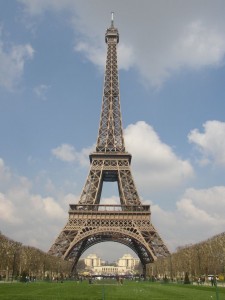This Thursday, March 31, will mark the 122 anniversary of the dedication of the Eiffel Tower in Paris on March 31, 1889. The

ceremony was presided over by Gustave Eiffel, the tower’s designer, and it was attended by the French Prime Minister Pierre Tirard, a handful of other dignitaries, and over 200 construction workers. We all know that the site is a “must-see” if you are ever visiting Paris, France. However, how many really know the history behind why this monument was built?
In 1889, to honor the centenary of the French Revolution, the French government planned an international exposition. At this event, they announced a design competition for a monument to be built on the Champ-de-Mars in central Paris. Over more than 100 designs were submitted, but the Centennial Committee chose Gustave Eiffel’s plan of an open-lattice wrought-iron tower that would reach almost 1,000 feet above Paris and be the world’s tallest man-made structure.
Eiffel was a noted bridge builder, a master of metal construction, and had designed the framework of the Statue of Liberty that had just recently been erected in New York Harbor. However, despite Eiffel’s obvious qualifications, his tower was greeted with skepticism from critics who argued that it would be structurally unsound. Others felt that it would be an eyesore in the heart of Paris. Undeterred by the massive amounts of indignation, Eiffel completed his tower under budget in just two years. Throughout construction, only one worker lost his life, a remarkably low casualty number for a project of that magnitude at the time.
Following the dedication, the light, airy structure was seen by all accounts as a technological wonder. Within a few years it became regarded as an architectural masterpiece. The Eiffel Tower was built 984 feet tall and consisted of an iron framework supported on four masonry piers. From these four piers rose four columns that united to form a single vertical tower. Platforms, each with an observation deck were placed at three levels. Elevators ascended the piers on a curve. The famous glass-cage elevators were actually constructed by the Otis Elevator Company of the United States.
These elevators, however, were not completed by March 31, 1889, so Gustave Eiffel and a few others ascended the tower’s stairs to raise an enormous French tricolor on the structure’s flagpole. Fireworks were also set off from the second platform. In early May, the Paris International Exposition opened, and the tower served as the entranceway to the giant fair.
The Eiffel Tower remained the world’s tallest man-made structure until the completion of the Chrysler Building in New York in 1930. The Eiffel Tower was almost demolished when the International Exposition’s 20-year lease on the land expired in 1909. However, its value as an antenna for radio transmission saved it. It remains today largely unchanged though numerous renovations have been completed over the years, and it is still one of the world’s premier tourist attractions.




